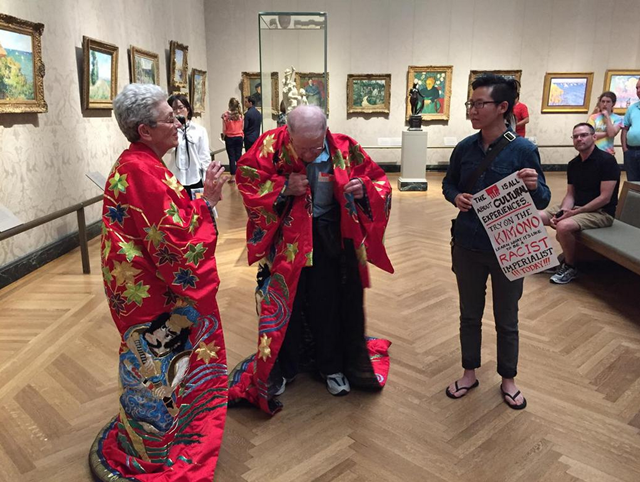BY: BRENNA PLADSEN
Shamelessly, with Hallowe'en around the corner, I thought it was apropos to highlight one of my favourite participatory museum activities: dress up stations! They are remarkably interactive, like Hallowe'en costumes, they offer up a rare chance to become embody army men of many ages, pioneers, pirates, Medieval and Victorian ladies alike. The power of role play as a guiding metaphor appears in other programming (see: character driven audio guides, persona tickets at the Titanic exhibition in Las Vegas, and most of the biodiversity gallery at the ROM). But costumes in informal learning setting tap into a visceral immersion that other senses strive, but often fail, to reach.
My own experience with dress up stations has primarily been in history exhibitions, and mostly before social media; particularly notable are the Victorian undergarments at the V&A and the Russian imperial military overcoat and hats at the National Art Museum of Norway (special exhibition, its a long story). Neither of which will be shared here. My most recent experience with dress up stations have been at the Bata Shoe Museum. There are two sets of shoes that patrons can try, the first are tiny, adult shoes made in miniature for kindergarten children. The second are brought out for Standing Tall: the Curious History of Men in Heels. Pointed at toe and heel, these patten red pumps are men's size 10-13. I was privileged enough to see grown men teetering across the tiles; first attempts at heels are always … fawn-like.
This dress up asks visitors to step into a very near reality, one that is simply a arbitrary gendered line away from their own. But, clothing can transport farther. Especially for historically accurate recreations, the garments in dress up stations are evocative of a particular way of moving through the world. The physical sensation of a corset being done up is not only demonstrates that its not that uncomfortable, but also that dressing for the woman that wore these was best accomplished as a team, a very different manner than getting dressed is now. The sheer weight and flex of a crinoline makes it dangerous to with the freedom and ease that our more casual present allows.
Frankly, if clothes maketh the man, there is little more immersive than seeing yourself in the clothes of another. Dressing up presents the opportunity to imagine the world differently, to expand out from the body and imagine the setting that these clothes are made for. They materiality of clothing and the rituals associated access pre-reflexive memory, one that is heavily tied to a conceptions of self and how that self is performed. Costuming, and the funny places outside of the everyday that allow for it, present an opportunity to shift slightly outside that.
Okay, so, I would like to end there, but I can’t. Because well, my previous argument is rooted in a basic assumption that is rapidly loosing traction. The privileged status of the museum as a reflective space is rapidly eroding. The experience I describe requires a dissonance from the everyday that becomes difficult as the hyper-performative modes of identity production become commonplace. Namely, selfies. Yes, sorry. The capture of novelty changes typified by digital culture changes the haptic character of costuming, and as the focus shifts from a internal negotiation into a an outward facing performance, the collapsing distance of space and time that I was hoping for is pretty much blown apart.
And I can’t touch on this topic without mentioning the Museum of Art in Boston and their recent controversy. The short summary is that the Museum of Art in Boston started a dress up program called “Kimono Wednesdays” around a replica of a kimono in Monet’s La Japoinaise. Report indicate that there was an initial loss of context was further compounded by the lack of context in resulting social media posts.
 |
| for example. Photo credit: Amber Ying, Twitter via Artnet News |
There were protests and counter-protests in the gallery, the program was downgraded to a hands-on but not full dressing station, and inspired a MFA panel discussion six months after. The painting and the kimono (as a wearable item), then went on a very successful Japanese tour. This example demonstrates some of the conceptual limitations of costuming. The multi-layered history, interwoven with a layer of satire multiple narratives of imperialism and racism, did not translate well. This speaks to limitations of type of experience. While it is powerful and evocative, dressing and garments cannot be completely stripped of there contemporary meanings. This is part of the power of dress, but also limits its ability to change thinking; it is habitual activity, so if novelty is an inherent part of the experience, it lack a certain subtlety.
On that cheerful warning, I’m going to start on my Hallowe’en costume. Have a spooky October.
Works Referenced
Goffman, Erving. (1959) The presentation of self in everyday life. Harmondsworth : Penguin.
Twigg, Julia and Christina Buse (2013). Dress, dementia and the embodiment of identity. Dementia. 12(3). p.326To-336


No comments:
Post a Comment
Note: only a member of this blog may post a comment.